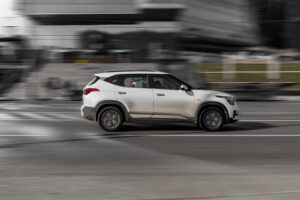
All-wheel drive (AWD) is a popular choice for drivers that want their vehicle to handle tough road conditions. This powertrain system delivers power from the engine and drivetrain to all four wheels. The system will adjust the torque provided to each wheel for the best distribution of power. Most AWD systems operate automatically through the vehicle’s computer, meaning that the AWD system is consistently engaged, and the driver doesn’t have to do anything to benefit from the feature. AWD is known for increasing traction and handling, resulting in a smoother ride.
There are advantages and disadvantages to AWD systems. Here are some points to note:
This is what AWD is made for! Drivers that want fantastic traction and handling in slippery, rocky, muddy, snowy or other challenging road conditions will want to have AWD. Since power is delivered to each wheel independently, an AWD system can prevent wheels from spinning, and provide additional stability and control in all terrain situations. It’s important to be aware that AWD does not impact stopping capability or steering.
Better traction means better acceleration. With a front-wheel drive (FWD) or rear-wheel drive (RWD) vehicle, only one set of wheels gets power. With AWD, each tire gets power to give a quick off the line start, which can help in everyday driving situations including merging onto the freeway from a metered stop.
AWD is an attractive feature to many drivers, and unless it comes standard, can be an add on through various packages or model upgrades. A vehicle that has AWD can see a bump up the resale value based on the original, higher starting price.
An AWD system can add hundreds of pounds increasing the overall weight of the vehicle. While acceleration is helped with an AWD system, it might be counteracted by the heavier weight of the car. The additional weight will also increase stopping distance, so drivers of AWD vehicles need to take that additional stopping length into account, particularly in challenging road conditions.
When you think about each wheel getting power of it’s own, and the additional weight of the AWD system, it makes sense that the vehicle will use more fuel. This means that AWD vehicles typically get lower MPG and range.
AWD can make a vehicle more costly to own in several areas. As noted above, AWD can have poor fuel economy, which means more frequent fill ups. Most vehicles do not come with AWD standard and needs to be added as part of a package upgrade at purchase. AWD systems also add additional mechanical and technology parts, which could need maintenance or replacement years down the line. Additionally, auto insurance rates are often higher for AWD vehicles.
It really depends on if you’ll make use of the feature and AWD capabilities. If you frequently drive in tough road conditions, live in an area that gets snow or ice, or enjoy off roading, then AWD makes sense. However, if you’re not going to be in driving situations that require AWD, a FWD or RWD could fit your needs and provide a more fuel- and cost-efficient owner experience.
Contact any of our dealerships to learn about available AWD vehicles.
While great effort is made to ensure the accuracy of the information on this site, errors can occur. Please verify all pricing information with a customer service representative. This is easily done by calling us or visiting us at the dealership.
Customer may not qualify for ALL Rebates shown. Some rebates are stackable and others can and cannot be combined. See Dealer For Complete Details.